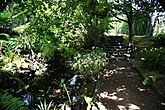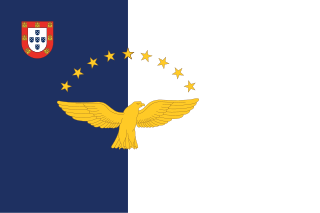
The Azores, officially the Autonomous Region of the Azores, is one of the two autonomous regions of Portugal. It is an archipelago composed of nine volcanic islands in the Macaronesia region of the North Atlantic Ocean, about 1,400 km (870 mi) west of Lisbon, about 1,500 km (930 mi) northwest of Morocco, and about 1,930 km (1,200 mi) southeast of Newfoundland, Canada.

Santa Cruz das Flores is a municipality situated in the north half of the island of Flores, in the Portuguese archipelago of the Azores. Situated in the sparsely populated Western Group, the population in 2021 was 2,020 inhabitants in an area that covers approximately 70.91 square kilometres (27.38 sq mi), bordering the southern municipality of Lajes das Flores.
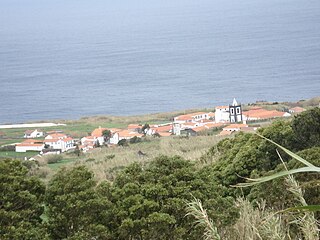
Cedros is a freguesia in the northern part of the municipality of Horta on the island of Faial in the Portuguese archipelago of the Azores. The population in 2011 was 907, in an area of 24.5 square kilometres (264,000,000 sq ft). The northernmost parish on the island, it is located 19 kilometres (12 mi) northwest of Horta and is linked via the Estrada Regional E.R. 1-1ª roadway to the rest of the island. The tree-covered hills and pasture-lands cover the interior, and hedged farmlands extend to the Atlantic coastline cliffs, a natural plateau above the sea, that was settled by early Flemish and Spanish colonists in the late part of the 15th century. Primarily an agricultural community, the population is comparable in size to other parishes on the island, though this has decreased by half since the 1950s. Today, it remains an agricultural centre of the island of Faial, anchored by the Cooperativa Agrícola dos Lactícinios do Faial, one of the primary rural industries on the island, responsible for sales of milk, cheese and butter.

Conceição is a freguesia in the municipality of Horta in the Portuguese Azores. The population in 2011 was 1,138, in an area of 3.08 km². It is the second smallest parish within the administration of Horta.

Flamengos is a Portuguese civil parish on the island of Faial in the archipelago of the Azores. Its name was derived from the grouping of Flemish settlers who made their homes in this landlocked valley, in the municipality of Horta. The population in 2011 was 1,604, in an area of 14.62 km². It contains the localities Cruz do Bravo, Farrobo, Lameiro Grande, Rua Nova, São Lourenço and Tafoneiro.

Praia do Almoxarife is a freguesia in the municipality (concelho) of Horta, of the Portuguese archipelago of the Azores. The population in 2011 was 834, in an area of 9.20 km2. Although it was the beachhead of early settlement on the island, its population has not grown significantly since it was settled. It has become an important summer destination and tourist center for its long black sand beach.

Picconia azorica, locally known as pau-branco, is a species of Picconia common to the majority of islands of the Portuguese archipelago of the Azores, where it is endemic. It can grow to a medium-sized tree, though it is usually found in the form of a shrub. It is threatened by habitat loss.

The Algar do Carvão is an ancient lava tube or volcanic vent located in the central part of the island of Terceira in the Portuguese archipelago of the Azores. It lies within the civil parish of Porto Judeu in the municipality of Angra do Heroísmo.
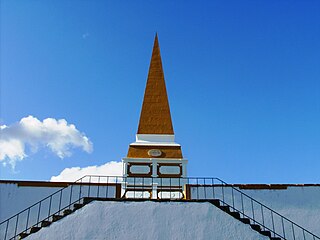
The Castle of Moinhos, officially known as the Castle of São Cristóvão, or Castle/Fort of São Luís is the name of the ruins of 16th-century fortification in city of Angra, on the Portuguese island of Terceira in the archipelago of the Azores. It is primarily known as the Castle of Moinhos, owing to the popular name given to the site for the number of mills that dotted the hilltop, on which the castle was erected.

The Fajã dos Cubres is a permanent debris field, known as a fajã, built from the collapsing cliffs on the northern coast of the civil parish of Ribeira Seca, in the municipality of Calheta, island of São Jorge, in the Portuguese archipelago of the Azores.
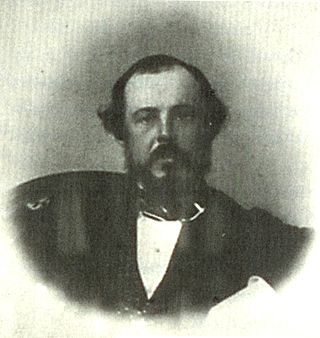
José do Canto was a Portuguese landowner and intellectual who distinguished himself as a bibliographer and promoter new agricultural technologies and species into the Azores. He was a renowned gardener and botanist responsible for the creation of botanical garden, that later bore his name, in Ponta Delgada. He was also a philosophical romantic and fan of Luís de Camões; his holdings included a large number of rare books in various languages, which were incorporated into the Azorean public library and regional archive.

The Lagoa do Negro is an ephemeral lake and humid zone located in the civil parish of Biscoitos, municipality of Praia da Vitória, on the island of Terceira, Portuguese archipelago of the Azores.

Duke of Terceira Garden is a manicured garden in the historical centre of Angra do Heroísmo, on the island of Terceira in the Portuguese archipelago of the Azores. One of the classic gardens emblematic of the Romantic period of Portuguese history, it is part of the municipal gardens of the city of Angra (located within the civil parish of Nossa Senhora da Conceição.

The Nature Park of Faial, or simply Faial Nature Park (PNF), developed from the intention of better managing the protected areas of the island of Faial, and was instituted by the Secretaria Regional do Ambiente e do Mar of the Autonomous Regional Government of the Azores.
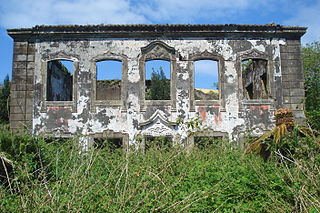
The Residence of Pilar is a Baroque-era residence, now in complete ruins, on Lomba do Pilar in the civil parish of Conceição, municipality of Horta, in the Portuguese archipelago of the Azores.

The 11th Regional Legislature was formed after regional elections held on 14 October 2012, in which the Azores Socialist Party. Representatives of the Assembly were elected from 57 constituencies, with the majority of the seats occupied by members of the Portuguese Socialist Party (PS), under the leadership of Vasco Cordeiro, who headed the 21st Government of the Azores, during the 11th Regional Assembly.
Pedro Soares de Sousa, also known as Pero Soares de Sousa exercised the role of the third Donatary-Captain for the island of Santa Maria, between 1571 and 1573, as well as between 1576 and 1580 and succeeded by Jerónimo Coutinho. He should not be confused with his descendant and seventh Donatary-Captain of Santa Maria, who in a testament dated 12 February 1634, referred to his 1616 ascendancy to the stewardship of Santa Maria.

The Captaincy General of the Azores was a politico-administrative structure of governance imposed in the Azores on 2 August 1766, with its seat in Angra. It remained the de facto system of governance for 65 years, until it was abolished on 4 June 1832 by D. Peter IV, but by 1828 its de jure status had made it nonoperational, owing to the revolutionary movements that lead to the Liberal Wars. The creation of the Captaincy-General was part of the Pombaline reforms to the Portuguese administration, during the reign of Joseph I, under the initiatives of Sebastião José de Carvalho e Melo, 1st Marquis of Pombal, then prime minister. A Captaincy-General operated from the Palace of the Captains-General, under the direction of the titular Captain-General, who operated as the Governor of the Azores, with additional jurisdiction on every island of the Azorean archipelago. The Captaincy-General was succeeded by the Province of the Azores, an ephemeral administrative structure that was collapse in the immediate years.







